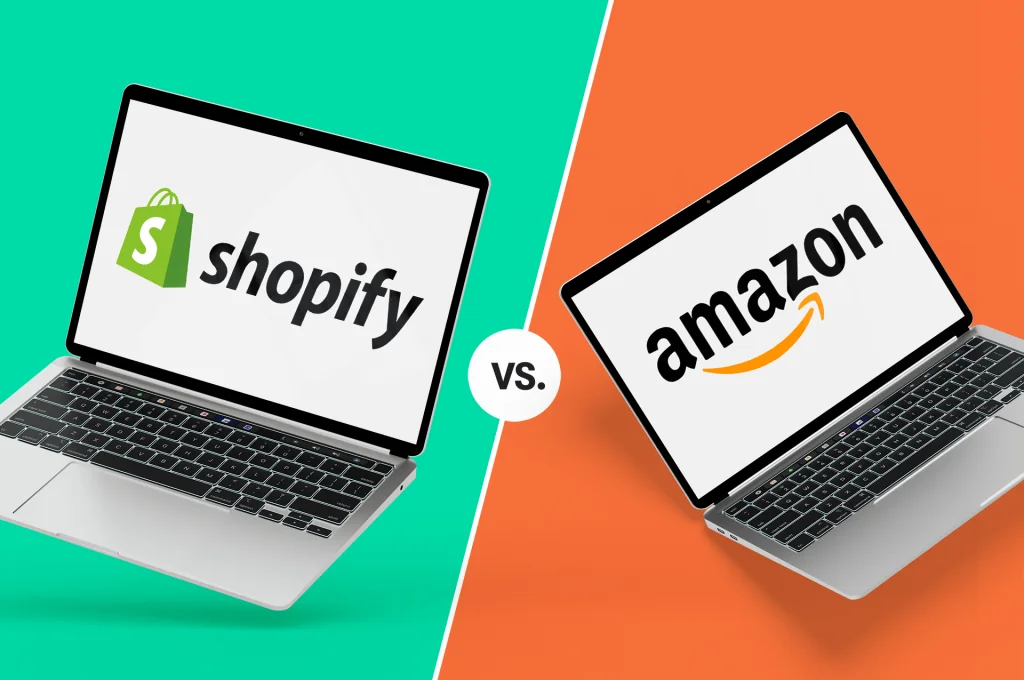As an eCommerce seller, there are several key decisions you need to make in order to give yourself a competitive edge. This includes choosing the best products, working with the most reliable suppliers, and, critically, which primary eCommerce platform to use to showcase your products and fulfill orders.
You have numerous choices, but Shopify vs. Amazon is a common decision for many eCommerce sellers. Choosing whether to make an online marketplace, like Amazon, or a platform to create and manage an eCommerce store, such as Shopify, your primary focus will set the tone for how most customers perceive your brand.
We’re going to walk you through how these platforms work with sellers so you can make an informed decision on how to sell your products, allowing you to scale your business and accelerate your path towards becoming an 8-figure seller.
Amazon vs Shopify: Pros & Cons
Both Shopify and Amazon allow you to manage inventory, sell products, process payments, and provide access to fulfillment networks. Beyond that, they have very different business models. Let’s look at how they differ and why it matters to sellers.
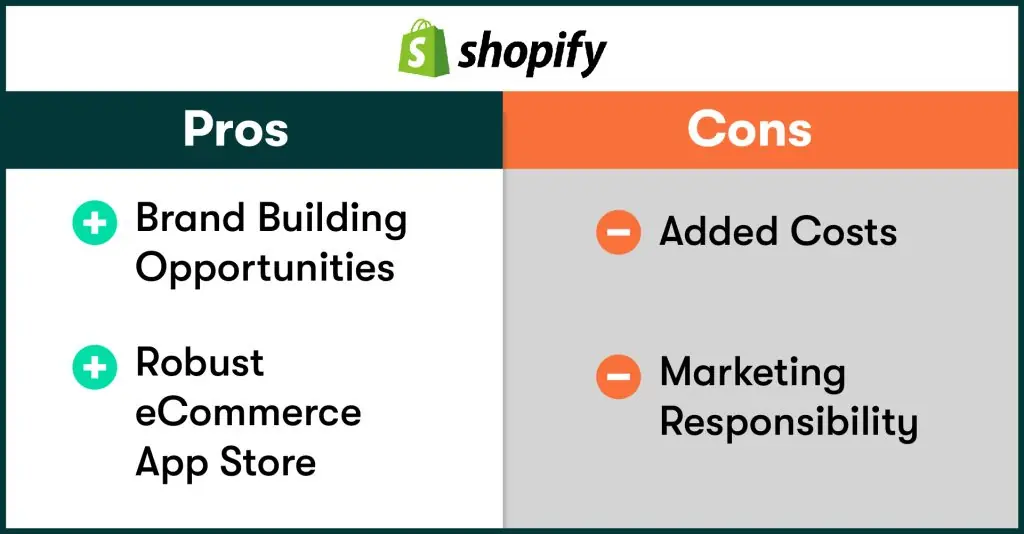
Shopify Pros
Shopify is a force to be reckoned with when it comes to eCommerce, as it powers more than 1.7 million businesses throughout 175 countries. The platform appeals to sellers because of its robust eCommerce toolset and brand-building capabilities.
Brand Building Opportunities
Shopify gives you complete control over how you present your brand to customers, allowing you to communicate who you are while strengthening your brand experience.
You can create and host an eCommerce website using any of their 70+ customizable templates. Their stores are easy to build, even with little to no web design experience. The sites are mobile-friendly and incorporate all the tools you need to sell your products online.
You can also integrate the Shopify Buy Button into an existing website for further brand control while still using their shopping cart and payment processing capabilities.
Robust eCommerce App Store
Shopify also provides sellers with everything they need to set up and manage their online store. In addition to a website and checkout software, they give users access to a library of over 6,000 third-party apps to help with fulfillment, marketing, tracking, reviews, coupons, and more.
These apps also provide access to additional sales channels, including top social media platforms, like Instagram and Tik Tok, or marketplaces, like eBay and Walmart.
Ownership of Client Data
Each order made through your Shopify store appears in a dashboard, along with the client’s name, email, and physical mailing address.
If you want to continue marketing and building a relationship with past buyers, Shopify provides you with all the tools needed to accomplish this, including email marketing platform integrations, abandoned cart notifications, and more.
Shopify Cons
While Shopify sellers experience many benefits utilizing the platform, there are some areas where the competition has an edge.
Added Costs
Shopify offers a selection of pricing plans, from its most basic plan at $9 per month to enterprise-level starting at $2,000 per month. The variety of choices ensures they have something to meet your needs, but that price isn’t all-inclusive if you want to get the most out of your store.
Some of their website templates come at an additional cost, and many of the apps that enhance your eCommerce store will require you to pay, whether it’s a one-time or ongoing fee.
There are additional fees if you want to be a part of the Shopify Fulfillment Network, which launched in June 2019. Their network handles packaging, using your branding, and shipping goods to your customers.
Marketing Responsibility
As a Shopify seller, you are responsible for developing and executing a marketing strategy. The platform aides sellers by providing access to marketing tools and apps, but the onus is on the store owner to effectively take advantage of what Shopify provides.
Shopify’s tools help you reach customers, but the platform doesn’t come with a built-in customer base like the Amazon marketplace.
Content Restrictions
Shopify specializes in eCommerce, meaning there are limits to its website builder. You’ll be restricted by the capabilities of your chosen theme. For example, some templates offer slideshows, while others have video. Some designs are single pages, while others are multi-page.
If you want a bespoke website, you can integrate the Shopify Buy Button; however, that will significantly limit the available app integrations.
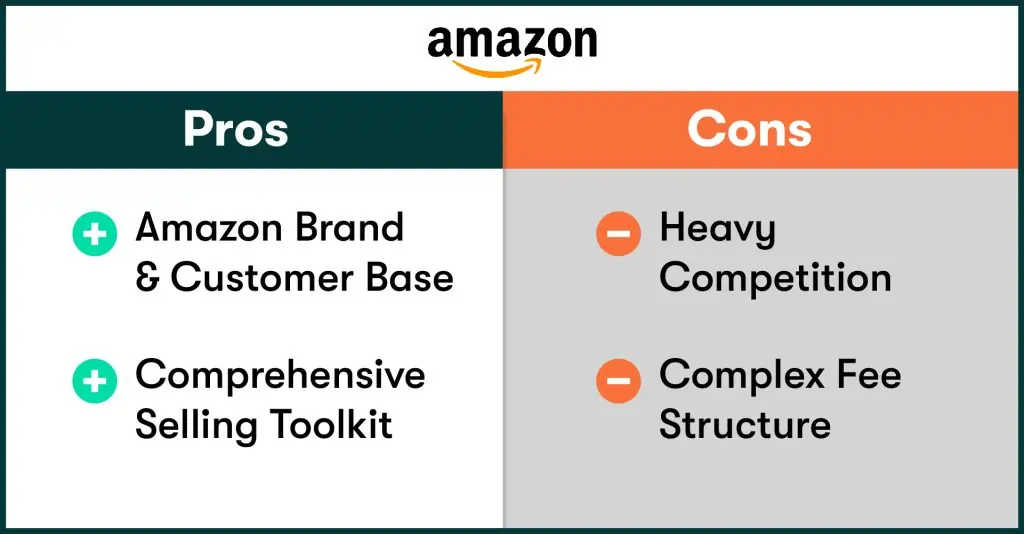
Amazon: Pros
Amazon is the leading eCommerce retailer in the United States, and the second most valuable brand in the world at $684 billion. Due to its size, the platform has incredible reach and continuously innovates to improve buyers’ and sellers’ experiences. As an eCommerce seller, this is a platform worth considering.
Amazon Brand & Customer Base
Consumers know and trust Amazon, which gives sellers an automatic customer base. Amazon has more than 300 million active customers, half of whom are Prime members, increasing their loyalty to the platform. Customers receive perks like free shipping, lower costs, and deals on the annual Prime Day event as well.
Amazon buyers purchase about 7,400 products each minute in the U.S. As 58% of sales come from third-party sellers, this gives your store an automatic market.
Access to the Amazon brand name and its buyers are some of the most significant benefits of selling on this platform.
Comprehensive Selling Toolkit
Amazon provides everything you need to sell your products, no store required. You control your business through Amazon’s Seller Central. This is where you manage payments and inventory, update product information, and access other helpful tools to successfully run your business on Amazon.
Additionally, they offer analytics, advertising tools, customer reviews, currency converter, and a price adjuster to help you stay competitive.
You can also enroll in Brand Registry, which gives you access to the Amazon store builder. This showcases your brand beyond the standard product listings and adds protection against infringements and inaccurate content.
Worldwide Fulfillment Centers
There are 185 Amazon fulfillment centers around the globe where they’ll take care of picking, packaging, and shipping your products. If you opt into Fulfillment by Amazon (FBA), you qualify for free two-day shipping, which is a huge selling point for buyers.
FBA will also handle customer service and returns, keeping you focused on scaling your business.
Amazon: Cons
Amazon is a leader in many respects, but some areas pose challenges for sellers. Some big cons include the amount of competition, a complex fee structure, and ever-changing rules that can severely impact your listing rankings.
Heavy Competition
In addition to Amazon itself, there are nearly 2 million third-party partners selling products on the platform. You must work to establish your brand and stand out amongst the competition.
Getting noticed is complicated by the fact that each product page looks the same. You can control your images, pricing, and descriptions, but there are limits on how you can make your product stand out in search results. Your best bet is running advertisements, maintaining positive reviews, and partnering with influencers to promote your products.
Complex Fee Structure
Amazon requires you to enroll in a selling plan. If you sell less than 40 units per month, you’ll pay $0.99 per unit sold. If your sales are higher than that, there’s a $39.99 monthly fee.
In addition, there are referral fees that range from 8% to 45% based on the category you’re selling in.
Amazon also allows sellers to enroll in optional programs to optimize their accounts and increase sales, incurring additional costs.
If you opt into FBA, there are additional storage and shipping fees, although the convenience of using FBA may make the price worth it. With 110 fulfillment centers in the United States, they can quickly deliver goods to your customers and you never have to handle the product you’re selling.
Lack of Customer & Listing Ownership
Amazon has control over everything listed on its website. While you can customize the content that goes up, there are limits on how you present that information. There are also listing restrictions that Amazon can enforce by removing or canceling your listing privileges.
Unlike Shopify, Amazon has full ownership of customers’ information, restricting your interactions to fulfillment-related inquires via the Buyer-Seller Messaging Service.
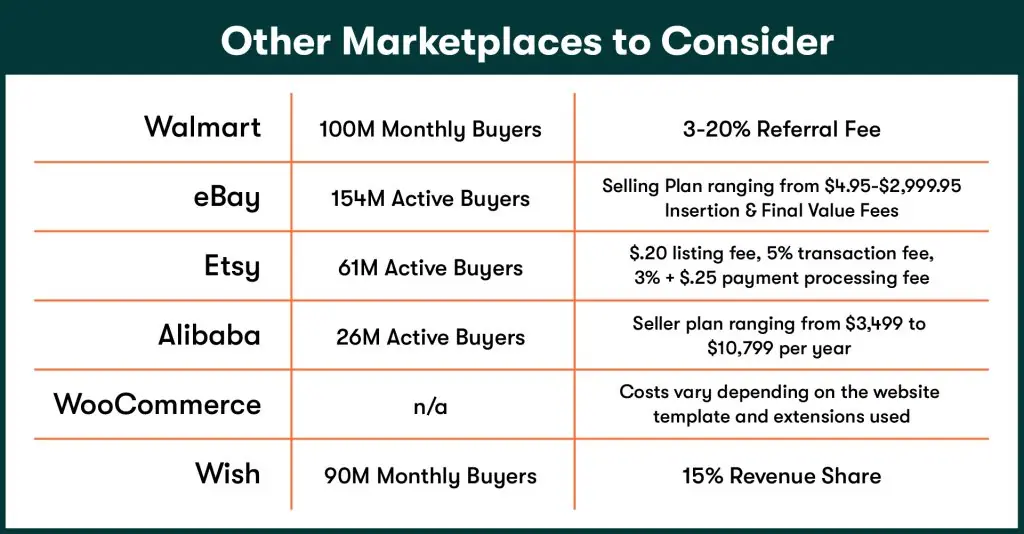
6 Additional ECommerce Marketplaces
Amazon and Shopify are two of the most prominent eCommerce platforms, but they’re not the only names in the game. There are other platforms that may be worth considering based on your goals.
1. Walmart
Walmart has an online marketplace much like Amazon. While most of their sales still come from their brick-and-mortar stores, Walmart is quickly becoming more competitive with eCommerce giant Amazon. Online sales reached $40 billion in 2020, with sales projections reaching $75 billion this year.
Sellers can list their products online to reach more than 100 million monthly shoppers. These buyers are looking for quality products with great prices and fast delivery.
Walmart handles payment processing and only charges a referral fee, ranging from 3% to 20% based on the selling category.
Walmart Fulfillment Services are also available to Walmart’s third-party sellers for a fixed monthly storage fee and a fulfillment price based on shipping weight. With more than 150 fulfillment centers throughout the U.S., they can get packages out of their warehouses and onto your customers’ doorsteps quickly.
2. EBay
EBay is a marketplace for both individuals and businesses, with 154 million active buyers across the globe. They offer services from inventory management to fulfillment for sellers of any category. Popular items include clothing, fashion accessories, car parts, and consumer electronics.
EBay sellers select a monthly selling plan ranging from $4.95 per month to $2,999.95 per month, as well as insertion and final value fees.
3. Etsy
Etsy is a creative marketplace for crafters, collectors, and artisans with 61 million buyers using their platform.
Etsy has the most specific criteria for selling on its channel. To sell on Etsy, you must offer homemade or vintage items. Manufactured goods are not allowed on the marketplace unless you had a role in the design or it fits into their definition of a craft supply.
Sellers create and customize their online Etsy shop and add product listings. Etsy handles payment processing and the seller manages their own order fulfillment.
Costs include a $0.20 listing fee, 5% transaction fee, 3% + $0.25 payment processing fee, and 15% ad fee when there’s a purchase through an Etsy ad.
4. Alibaba
Alibaba is a B2B wholesale marketplace with 26 million active buyers across the globe. It offers a storefront, advertising tools, and order management.
Seller plans range from $3,499 to $10,799 per year, with the main differences being support level and advertising spend.
While you can have success buying and selling on Alibaba, be cautious as it does have a reputation for scams. Be thorough when vetting suppliers and researching before making a purchase.
5. WooCommerce
WooCommerce is an eCommerce platform similar to Shopify, but with a more limited toolset. Like Shopify, you can use templates to create and customize your eCommerce website or add it as a plugin to your existing WordPress site.
They give you access to hundreds of extensions that can support marketing, shipping, and more.
Costs vary depending on which theme you choose for your site. It can also be affected by which extensions you use for marketing, payment processing, and shipping.
6. Wish
Wish is a mobile-first eCommerce marketplace that curates a product feed based on its user interactions. Its 90 million monthly buyers are looking for bargain prices on fashion, beauty, home décor, and tech accessories.
Wish take a 15% revenue share on each order, with no other fees or subscriptions required. Fulfillment can be outsourced, completed in-house, or handled through Fulfillment by Wish, although there is only one warehouse located in the United States.
How to Choose A Primary ECommerce Marketplace
When deciding between the current U.S. leaders, Shopify vs. Amazon, pricing will always be a consideration. However, the primary difference is how the platform will present your brand.
With Shopify, it’s all about your brand. You build your website and have the flexibility to use your logo on your packaging. If you’re trying to differentiate your company and build brand loyalty, Shopify is a great fit.
With Amazon, its own brand is front and center. If you’re more focused on getting your products into customers’ hands and less concerned with brand recognition, Amazon may be the way to go.
And, if it all sounds good to you, you can have it both ways. Many retailers tap into Amazon’s massive network of buyers and fulfillment centers while building their own Shopify eCommerce site to solidify their brand’s place in the market.
Get into the mindset of your buyer. Are they searching on Amazon? Or is your product new to the marketplace, requiring external marketing? Are your products competitively priced or is the emphasis on quality and brand experience? Develop an eCommerce strategy to maximize your product reach and expand your online presence, which may include one or multiple platforms.
Strengthen Your Entire Supply Chain
Once you’ve decided which platform will be the primary host for your eCommerce store, it’s time to get your product supply chain moving. 8fig provides a free growth planning tool, so you have a complete view of your logistics process. Seeing each step in your supply chain can let you plan, optimize, and adapt to disruptions down the road.
For sellers generating $8,000 or more in monthly revenue, we also offer equity-free, adaptable, and unlimited capital that aligns cash flow to every step in your supply chain. Grow your eCommerce business and become an 8-figure seller by strengthening your entire logistics and funding process.
Sources:
Built with | Investor’s Business Daily
to our blog
Read the latest
from 8fig

Not ensuring that your sales forecasts are accurate can seriously impact sales. Learn to avoid the most common mistakes to ensure uninterrupted growth.
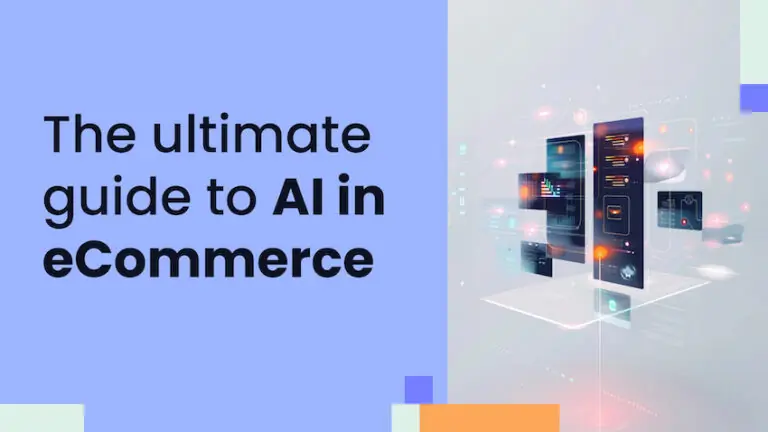
AI is here to stay, especially when it comes to eCommerce. Sellers that leverage it can gain a crucial advantage over competitors.
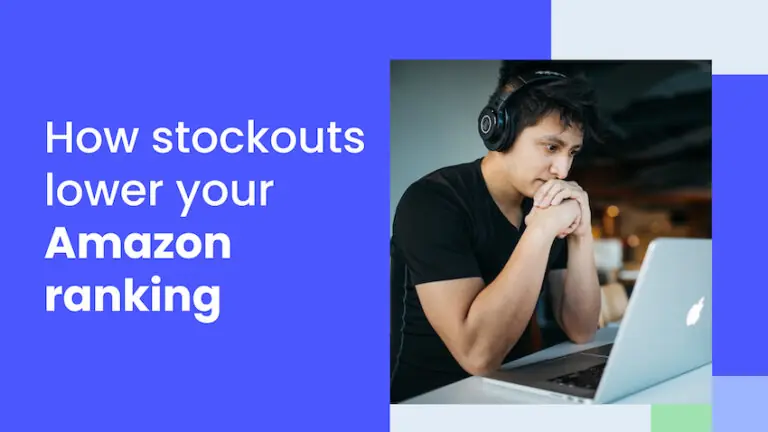
Learn how running out of stock on Amazon lowers eCommerce stores’ ranking and harms their future sales potential.
